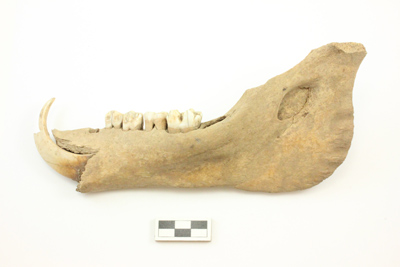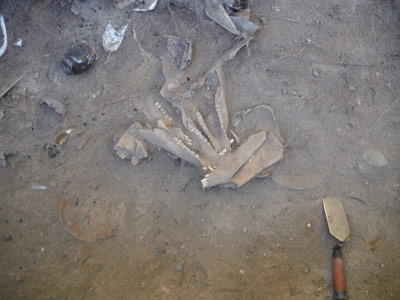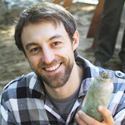Digging Jacksonville – April 2015
In 2013, the Southern Oregon University Laboratory of Anthropology (SOULA) excavated a burned house in what was formerly Jacksonville’s Chinese Quarter. Thousands of bones, or faunal remains, from a variety of animals were recovered in the dig. All artifacts can tell us something unique about their time and place in history and the people who made or used them. Different kinds of items tell different stories—an arrowhead might say something about where someone was hunting, or where they crafted their tools, while an unassuming rusty tin might tell what brand of tobacco they preferred. Judging by the extensive evidence of butchery, and the variety of the excavated animal remains, we can learn something about the occupants of the Chinese Quarter, as these bone artifacts represent the remains of meals eaten by the residents.
However, the story doesn’t end there. Questions regarding the details of how those bones came to be deposited emerge: “Where did the meat come from?” “What kinds of animals were being eaten?” “How were these animals butchered?” These questions might seem uncomplicated at first, but they all have the potential to help us greater understand the complexity of life for people living in the past.
Let’s look at “Where did the meat come from?” We know that the residence that was excavated sat next door to the Orth Butcher Shop, where many of Jacksonville’s residents during the 19th century went to purchase meat. We also have documentation of local ranchers selling pigs to members of the Chinese community. On top of that, census records indicate a Chinese butcher lived in Jacksonville during this time period. Chinese residents also purchased foodstuff exported from mainland China, so “traditional” food items were often available for Chinese residing on the western frontier.
These different avenues can all tell us something about the relationships between people living in the past. Faunal analysis can be used to explore these relationships—the bones excavated from sites such as the Chinese Quarter record the evidence of these interactions in the form of butchery marks. By analyzing these markings and comparing them to what we know about butchering techniques, tools, and cultural perceptions about food we can reconstruct the network of relationships that led to the remains finally being deposited at our site. For example, the tools and techniques used at the Orth Butcher Shop likely differed greatly from those used by the Chinese butcher living elsewhere in town. If it is found that the household was purchasing meat from the Orth shop rather than from the Chinese butcher, we could presume that the different ethnic communities living in Jacksonville were not as divided as it might be expected. With such analysis we can learn about the social and economic reality of the people living in the house prior to its destruction. A better understanding gained from a modest pile of old bones.
The excavations in the Jacksonville Chinese Quarter were funded by the City of Jacksonville and the Oregon Department of Transportation.
Featured image above: This pig jaw was just one of the thousands of fragments of butchered animal bones recovered from the Jacksonville Chinese Quarter.


 Kyle Crebbin received his B.S. in Anthropology from SOU, and is working with SOULA until he begins graduate school at the University of Nevada, Reno next fall 2017. You can reach SOULA by contacting Chelsea Rose at rosec@sou.edu and follow SOULA on
Kyle Crebbin received his B.S. in Anthropology from SOU, and is working with SOULA until he begins graduate school at the University of Nevada, Reno next fall 2017. You can reach SOULA by contacting Chelsea Rose at rosec@sou.edu and follow SOULA on